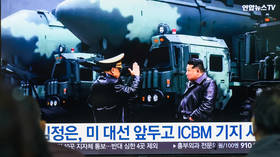AIDS: questions remain unanswered
Healthcare officials, government representatives and scientists from around the globe have gathered in Vienna for 2010 AIDS conference amid the heated debates over what causes the disease and how it should be treated.
Some striking figures emerged during the conference: 33.4 million people are HIV-positive, 2.7 million are newly infected and two million die each year, and 10 million are on the waiting list for treatment. Eastern Europe and Central Asia are the areas of special concern since here the number of those infected is growing despite the reverse trend in the rest of the world.
Among the issues raised were general access to treatment and concerns that the G8 countries have failed to keep their funding commitment.
However some feel that the money allocated is not being spent properly. Thus, former US President Bill Clinton, who spoke at the conference, called on HIV and AIDS organizations to ensure that they are efficient in delivering their services rather than complaining about the lack of funds.
When the AIDS epidemic first hit the headlines in the 1980s it caused widespread panic. For Arthur Singer, who was one of the first diagnosed, it was a terrifying experience.
“It was 1986 where the information was just in magazines and headlines saying AIDS kills and calling it the homosexual disease,” he said. “Being one of the first diagnosed was a big hit for me – you get depressed and think you are going to die because that is the information you have gotten. A deadly virus and that is it.”
US scientists identified HIV as the cause and developed a successful test to detect its presence. However, this has, itself, been the subject of scientific disagreement.
Some believe there are different causes of AIDS, not just HIV, and cast doubt on the standard HIV test, which is based on detecting the presence of the HIV virus.
Joan Shenton, the founder of the Immunity Resource Foundation, says her organization has been challenging the conventional perception of HIV and AIDS for 24 years. According to Ms. Shenton, not only is the conventional treatment inefficient, but even conventional HIV tests are also not reliable.
“The HIV test is an absolute crime. You can test positive for HIV if you have 67 conditions… TB, syphilis, malaria, invasive mycosis,” says Joan Shenton.
“At the University of Surrey we put 35 samples through three different test kits. Two of the test kits showed pretty similar results, the third test kit showed 19 people who were in the sort of no-man’s area. One of the young people tested negative twice when we took him to London teaching hospitals, but he had tested positive three times in our blind trial.”
“While you might think there are only a handful of scientists who doubt the HIV/AIDS theory, here at the conference is a list of around 2,500 names – all scientists who challenge the classic definition,” said doctor Uta Santos-Konig.
However, Dr. Andrew Ball from the HIV/AIDS Department at the World Health Organization emphasized that without doubt there is “very clear evidence that HIV is the cause of AIDS.”
“This is an old issue. It’s an issue that has been dealt with. Of course science has to be open to any new evidence, but as far as we are concerned, there certainly isn’t any new evidence to demonstrate anything otherwise,” he stressed.
Those dissenting from the conventional view that HIV causes AIDS say they can face open hostility from their scientific peers. Not agreeing with the mainstream HIV theory of AIDS has even been compared to Holocaust denial, and called a crime against humanity.
“I think the expression ‘AIDS denial’ is nothing but polemic. Nobody denies there exists an Acquired Immune Deficiency Syndrome, but a science that is alive has to have the permission to question a certain model of thinking,” Santos-Konig said.
“We are all scientists and medical doctors, why should we not be able to discuss?” she added. “I am astonished that the reaction is sometimes so aggressive.”
There was a heated debate on RT between two AIDS experts – Alan Berstein from the Global HIV Vaccine Enterprise and Juliana Sacher – a doctor who questions official HIV/AIDS theories.
Some, too, have differing views as to treatment.
Doctor Claus Koehnlein, medical practitioner, noted the mistreatment of HIV patients within the framework of conventional medicine in the 1990s.
“I was witness of mass intoxication of the patients with AZT. AZT was the first recommended treatment and we all know today that it was much too high in the dosage. We gave 1500 mg on a daily basis and that virtually killed everybody who took this treatment. That is the reason why everybody believes that HIV is a deadly virus. There is still no proof for this assumption,” says Doctor Claus Koehnlein.
“The treatment nowadays is in some cases good for patients who have chemical AIDS, that means in the gay community, those who are taking drugs and getting AIDS after years – they [can benefit] from the treatment that is given today,” adds Mr. Koehnlein.
Arthur Singer and his doctor use alterative therapies, as opposed to conventional HIV-fighting drugs.
So strong is his belief in these other treatment methods that he has written a book, “23 Years Positive”, on his experiences.
“I thought, ‘Oh yes, I have finally found an explanation that makes sense and I can live with that truth.’ It is the only truth I have found so far,” Singer told RT.
Dr Marco Ruggiero from the University of Florence believes there could soon be a breakthrough in treating HIV, as recent tests suggest that stimulating the immune system can rid the body of the virus.
“Just last year, Professor Yamamoto from Japan published a paper (in a prestigious journal of medical virology), demonstrating that HIV infection can be eradicated by stimulating the immune system,” he told RT.
“It is not so easy but, yes, we can say that there could be alternative cures that have already been published, and we are just confirming our data with those results.”
Christian Fiala, a doctor of medicine, challenges the mainstream views on HIV/AIDS.
He told RT that his views are different because he is not driven by the interests of pharmaceutical companies.
Gregory Adams of Oxfam America says without an overhaul of healthcare systems, money from donors will do little to help those with HIV.
“It cannot exist in a vacuum. If you have an entire strategy that is based on donor supported delivering of pharmaceuticals, without building the health system – the doctors, the nurses – the system that actually supports health in the country, you are not setting yourself up to get ahead of the crisis,” he told RT.













